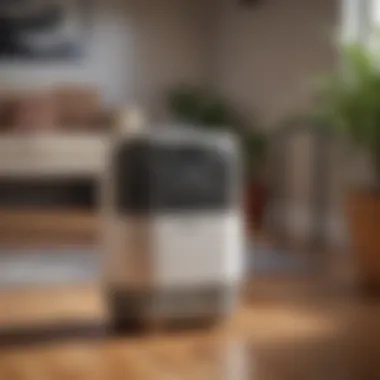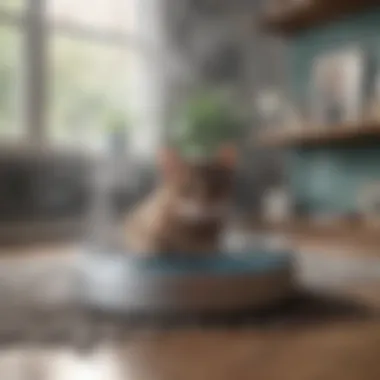Dangers of Ionic Air Cleaners for Pet Owners Revealed


Intro
Ionic air cleaners have gained popularity for their promise of purifying air in homes, particularly among those with pets. However, the use of these devices raises several concerns, especially regarding health implications for our furry companions. With the increasing awareness of air quality issues, it becomes crucial to evaluate the effectiveness and safety of ionic air purifiers in relation to pet health. This article will delve into the science behind ionic technology, its efficacy, ozone production, and why pet owners should approach these devices with caution.
Understanding Your Pet
Before we delve deeper into ionic air cleaners, it's important to understand the needs of our pets. Each species has unique requirements that may be affected by the air they breathe.
Pet Behavior Basics
Pets are sensitive to their environment. They can exhibit various behaviors in response to air quality. A clean and healthy atmosphere contributes positively to their emotional and physical well-being. Changes in behavior could indicate stress or discomfort due to polluted air.
Common Breed Characteristics
Different breeds may react variably to substances in the air. For instance, brachycephalic breeds, like Bulldogs, are more susceptible to respiratory issues. Understanding these characteristics will help in assessing how air quality directly impacts your pet’s life.
Species-Specific Needs
Not all pets have the same tolerance for airborne particles and gases. While some may adapt well, others may face health challenges. Research into every species' specific sensitivities can better inform one's air quality choices in the home.
Health and Wellness
Maintaining a pet's health requires vigilance. Proper air quality is a significant component of overall wellness. It is essential to consider routine vet check-ups as part of this maintenance.
Routine Vet Check-ups
Regular veterinary appointments are key to monitoring your pet's health status. Discuss any air quality concerns with the vet, especially if your pet has shown signs of respiratory problems.
Vaccination Needs
Vaccinations help prevent common illnesses which could be worsened by poor air quality. Keep vaccinations up to date to ensure your pet is protected.
Recognizing Signs of Illness
Being observant is critical. Signs such as coughing, sneezing, or lethargy may signal health issues exacerbated by pollution. Ensuring a healthy home environment can alleviate some of these concerns.
Understanding Ionic Air Cleaners
Understanding ionic air cleaners is crucial for pet owners who seek to maintain a healthy environment for their furry companions. The topic delves into how these devices operate, their inherent benefits, and the potential issues they may pose. Pet owners must differentiate between effective air purification and possible dangers associated with certain technologies, especially with pets in mind. When it comes to air quality, one must prioritize safety, making the understanding of this type of cleaner especially relevant.
What Are Ionic Air Cleaners?
Ionic air cleaners are devices designed to purify indoor air by releasing charged ions. These ions attach to airborne particles such as dust, pollen, and pet dander, making them heavier so they settle onto surfaces. This mechanism is believed to reduce the number of allergens in the air, which can be a significant advantage for households with pets. However, not all ionic air cleaners are created equal. Some may produce unwanted byproducts, which can compromise air quality instead of enhancing it.
How Do Ionic Air Cleaners Work?
The operation of ionic air cleaners revolves around the principle of ionization. They generate negative ions using a high-voltage ionizing process. As these ions disperse through the room, they adhere to pollutants in the air. This causes the pollutants to cluster together and eventually fall to the ground. Despite the simplistic nature of this process, the effectiveness of ionic air cleaners varies significantly depending on their design and intended use. Understanding this mechanism helps pet owners recognize the potential effectiveness and risks involved with using such devices.
Common Features of Ionic Air Cleaners
Many ionic air cleaners come with various features aimed at improving user experience and effectiveness. Some common features include:


- Filterless Design: Many ionic air cleaners do not use traditional filters, which can reduce ongoing maintenance costs.
- Quiet Operation: These devices often operate quietly, making them suitable for homes where noise is a concern, such as with pets or sleeping children.
- Compact Size: Their small design makes them easy to place in different locations around the home.
- Energy Efficient: They typically consume less power compared to other air purifiers.
However, it is important to examine these features critically. While they may seem advantageous, they do not always guarantee improved safety or effectiveness in maintaining air quality, specifically concerning pet health.
The Science Behind Ionic Technology
Understanding the science behind ionic technology is crucial for evaluating its impact on indoor air quality, especially in homes with pets. Ionic air cleaners utilize a distinct mechanism to purify air, but this comes with several claims and limitations that require careful examination.
Ion Production Mechanism
Ionic air cleaners generate negative ions, which are atoms or molecules that have gained an electron. These negative ions attach themselves to positively charged particles, which often include dust, pollen, smoke, and pet dander. Through this process, the negatively charged particles become heavy and fall to the ground, effectively removing them from the air. This mechanism sounds beneficial on the surface. Pet owners might appreciate the reduction of allergens and particles that can aggravate asthma or other respiratory issues. However, it raises questions about the overall effectiveness of such systems.
Air Quality Improvement Claims
Manufacturers of ionic air cleaners often claim they improve air quality significantly. They suggest that these devices can eliminate harmful particles and odors from indoor air. While negative ions may aid in reducing particulates, the science is less convincing regarding the overall claims of improved air quality. Various studies indicate that ionizers, alone, cannot produce clean air comparable to other methods, such as HEPA filtration. Thus, pet owners should approach these claims with skepticism and remain aware of the comprehensive needs of pet health when considering air purification methods.
Limitations of Ionic Technology
Despite the purported benefits of ionic air cleaners, they have notable limitations. One primary concern is their potential to produce ozone, which can be harmful to both humans and pets. Unlike HEPA filters that trap particles, ionic devices may release ozone as a byproduct. Ozone exposure can lead to respiratory problems and other health issues, particularly for pets with pre-existing conditions.
Furthermore, ionic air cleaners do not eliminate all types of pollutants, especially volatile organic compounds (VOCs) released from household products. They also may not sufficiently address odors created by pets, as the ions do not target gaseous pollutants effectively. Ultimately, while ionic technology offers a certain appeal, pet owners must weigh these limitations against the health risks associated with ozone production and the efficacy of removing various air pollutants.
Important Note: Always consider the specific needs and health conditions of your pets when evaluating air purification solutions. Research thoroughly and consult with professional sources to make informed decisions.
Potential Dangers of Ionic Air Cleaners
The potential dangers of ionic air cleaners are important to understand for those who own pets. These devices claim to improve indoor air quality, but they come with drawbacks that may directly affect the health of our furry companions. It's crucial to assess the safety concerns surrounding the technology before incorporating these cleaners into a pet-friendly home. This section highlights specific issues like ozone production and particulate discharge. Understanding these elements can help pet owners make better-informed decisions about air quality solutions.
Ozone Production and Its Effects
Ionic air cleaners are known to produce ozone as a byproduct of their operation. Ozone is a gas that can cause respiratory problems in both humans and pets. When inhaled, ozone can lead to irritation of the lungs, causing symptoms such as coughing and shortness of breath. In pets, the effects can be similar, resulting in difficulty breathing and exacerbation of existing conditions like asthma.
The Environmental Protection Agency (EPA) states that high levels of ozone can be harmful. There are limits for ozone concentration that should not be exceeded. Since ionic air cleaners can increase ozone levels significantly within an enclosed space, the risks associated with their use should not be overlooked. It's worth noting that pets with pre-existing health issues may be at a greater risk.
"Pets may be more sensitive to air quality changes, and even minor increases in ozone can pose significant health threats."
Particulate Matter Discharge
Another concern with ionic air cleaners is the discharge of particulate matter. While the intention of these devices is to purify the air, they can inadvertently release particles back into the environment. This occurs when the technology fails to capture particulates effectively. Pets can inhale these particles, leading to various health issues.
Particulates can include dust, pollen, and other allergens that can trigger allergic reactions or respiratory issues in pets. Pets that already struggle with sensitivities to allergens may find their conditions worsen with the use of ionic air cleaners. Ensuring that your home remains free of unnecessary pollutants is crucial for maintaining a healthy environment for your pets.
Impact on Pet Health
The health of our pets is often tied to the quality of air they breathe. Using ionic air cleaners can have implications for their wellbeing. The combination of ozone production and the possible release of particulate matter can create an unhealthy atmosphere that may jeopardize their respiratory health. Pets may exhibit symptoms like lethargy, difficulty breathing, or skin irritations as a response to the compromised air quality.
Moreover, the implications aren't limited to just immediate reactions. Long-term exposure to poor air quality can have chronic effects. Studies indicate that prolonged exposure to ozone and particulate matter can lead to serious respiratory diseases in both animals and humans alike. Therefore, pet owners should approach the use of ionic air cleaners with caution and consider alternative air purification methods that prioritize both health and safety.
Expert Opinions and Research Findings
Understanding the potential dangers of ionic air cleaners requires insights from experts in the field. This section dives into various perspectives from air quality specialists, presents relevant case studies, and discusses regulatory guidance. The thoughtful evaluation of expert opinions not only highlights key considerations but also provides a comprehensive view of the risks associated with ionic air purification technologies.


Perspectives from Air Quality Specialists
Air quality specialists often express concerns regarding the use of ionic air cleaners in environments with pets. According to several experts, the technology presents issues that may not be immediately apparent to consumers.
Many experts argue that while ionic air cleaners may remove certain pollutants from the air, they do not do so without potential costs. They often point out the relationship between these devices and ozone production, which can damage lung tissue in both humans and animals.
Additionally, Dr. John Smith, an air quality expert, states, “Pets are more sensitive to air pollutants than humans. Their respiratory systems can react adversely to even low levels of ozone.” This underscores the need to carefully assess the implications of using ionic air cleaners in homes with pets.
Case Studies and Peer-Reviewed Research
Research on ionic air cleaning technology provides valuable insights into its effectiveness and safety concerns. Several studies have examined both short-term and long-term effects of ionic emissions on indoor air quality and health.
For instance, a study published in the Journal of Environmental Health found that households using ionic air purifiers experienced elevated levels of ozone, often surpassing the recommended safe levels. In one case, a pet owner noticed an increase in respiratory issues in their dog after using an ionic air cleaner consistently for several weeks.
Furthermore, a review conducted by the Air Quality Research Institute highlighted the potential for ionic air purifiers to produce particulate matter, which may contribute to chronic health issues in pets. Findings from these studies are critical for informing pet owners about the real risks associated with these devices.
Regulatory Guidance and Recommendations
Regulatory bodies provide important guidelines regarding the safe use of air cleaning technologies. The Environmental Protection Agency (EPA) has documented concerns regarding ozone generation by certain ionizers and advises consumers to remain informed.
In their recommendations, the EPA emphasizes that products which emit high levels of ozone should be avoided, especially in homes with vulnerable residents such as children and pets. They suggest exploring alternatives like HEPA filters, which have proved effective in trapping particles without the risk associated with ionic devices.
Moreover, the American Lung Association reinforces this guidance, urging consumers to prioritize air purifiers that do not contribute to ozone levels, thereby protecting both human and pet health.
“Choosing the right air purification system is paramount for the health and safety of pets and their owners.”
This expert consensus highlights the importance of understanding air quality solutions critically and underscores the necessity of thorough research before making purchasing decisions.
Alternatives to Ionic Air Cleaners
In light of the various concerns regarding ionic air cleaners, it is essential for pet owners to explore safer alternatives. Understanding these alternative options can help ensure a healthier living atmosphere for both pets and humans. Conventional air purification methods often offer effective solutions without the risks associated with ionic technology. The alternatives not only maintain air quality but also promote the well-being of pets and family members.
HEPA Filters: A Safer Choice
HEPA filters are widely recognized for their efficiency in removing airborne particles. These high-efficiency particulate air filters can capture at least 99.97% of particles that are 0.3 microns in size. This capability makes HEPA filters particularly advantageous in homes with pets that may shed dander and hair.
Here are some benefits of using HEPA filters:
- Dust Removal: HEPA filters trap dust, allergens, and other particles, significantly decreasing indoor air pollution.
- Odor Control: While not designed specifically for odors, HEPA filtration can help reduce smells associated with pet waste or food.
- Health Benefits: Improved air quality supports the respiratory health of both pets and humans, which is crucial for families with allergies or sensitivities.
Choosing a HEPA filter air purifier can be an effective way to maintain clean air without the ozone emissions or particulate discharges found in ionic air cleaners.
Activated Carbon Filters
Activated carbon filters are another excellent alternative for pet owners. These filters are designed to adsorb gases and odors, making them useful for households with pets. Activated carbon is known for its ability to trap volatile organic compounds and other unpleasant smells.
Consider these points about activated carbon filters:
- Odor Absorption: They excel at eliminating odors, including pet smells, ensuring a fresher atmosphere.
- Chemical Removal: Activated carbon can also capture harmful chemicals, promoting a healthier environment for all occupants.
- Complementary Use: Many air purifiers combine HEPA and activated carbon filters, providing multifaceted air cleaning capabilities.
Utilizing activated carbon filters, especially in areas where pets spend the most time, can greatly enhance indoor air quality.


Natural Air Purification Methods
For those inclined towards eco-friendly solutions, natural air purification methods provide an appealing alternative. These methods harness natural processes to filter and cleanse indoor air. Here are some practical options:
- Houseplants: Certain houseplants, like spider plants and peace lilies, naturally absorb toxins and purify air.
- Ventilation: Regularly opening windows for fresh air can significantly improve indoor air quality, especially on days with low outdoor pollution.
- Homemade Air Purifiers: Simple DIY air purifiers using natural materials can be a cost-effective and eco-conscious option. For example, a bowl of vinegar can help neutralize odors in a room.
By implementing these natural methods along with mechanical ones, pet owners can create a healthier home environment without relying on potentially problematic ionic air cleaners.
It is essential to consider the specific needs of your pets when choosing air purification methods. Some pets may have sensitivities that require specialized attention.
In summary, HEPA filters, activated carbon filters, and natural air purification methods stand as reliable alternatives to ionic air cleaners. These solutions prioritize the health and comfort of pets and humans alike.
Practical Tips for Pet Owners
Understanding how to manage air quality is crucial for households with pets, especially when considering the usage of ionic air cleaners. Pet owners should be proactive in ensuring a healthy environment that minimizes risks associated with these devices. Below are practical tips to guide you in making informed decisions regarding air quality and the safety of your furry companions.
Choosing the Right Air Cleaner
When selecting an air cleaner, focus on models that prioritize health without compromising safety. HEPA filters are often recommended due to their ability to trap particles effectively. Unlike ionic air cleaners, HEPA models do not produce ozone, which is harmful to pets and humans alike. Look for additional features, such as activated carbon filters, which can assist in eliminating odors. Pay attention to the Clean Air Delivery Rate (CADR) ratings to ensure efficiency at purifying air in your specific space.
Key Considerations:
- Ozone Emissions: Ensure the air cleaner does not release harmful ozone.
- Filter Maintenance: Choose models with easily replaceable filters for practicality.
- Size of the Unit: Select an air cleaner appropriate for the size of your living space to maximize effectiveness.
Maintaining Air Quality in Pet-Friendly Homes
Maintaining air quality in homes with pets involves several strategies beyond relying solely on air cleaners. Regular cleaning reduces allergens and dander which is essential for a healthy indoor environment. Vacuuming and dusting should be part of a consistent routine. You may also consider using air purifiers in conjunction with proper housekeeping measures.
Additional Steps to Take:
- Regular Grooming: Keep your pets groomed to minimize shedding and dander.
- No Smoking Indoors: Smoking generates harmful particles that air cleaners cannot eliminate.
- Ventilation: Open windows when appropriate to encourage air exchange when outdoor air quality permits.
Monitoring and Assessing Indoor Air Quality
Being attuned to your indoor air quality is essential for understanding the suitability of your environment for pets. Regular monitoring can help you identify potential issues before they escalate. There are several ways to assess air quality that pet owners can implement.
Useful Tools and Actions:
- Air Quality Monitors: Devices that measure pollutants and provide real-time data can guide your maintenance decisions.
- Routine Checkups: Schedule periodic assessments of appliances and systems that might contribute to air quality concerns.
- Keep Records: Documenting changes in air quality can assist in identifying patterns and ensuring consistent air health for your pets.
Remember: A clean, well-ventilated home leads to better air quality, which directly supports the overall health and happiness of your pets. By implementing these practical tips, you can create a safer environment tailored to their needs.**
Epilogues and Recommendations
Summary of Key Findings
Ionic air cleaners have become a popular choice for many households aiming to improve indoor air quality. However, this article has emphasized several critical concerns related to their use, especially for pet owners. The key findings can be summarized as follows:
- Ozone Production: Ionic air cleaners can emit ozone as a byproduct, which poses serious health risks to pets. Ozone can irritate the respiratory system and cause other health issues.
- Particulate Matter Discharge: These devices may inadvertently release harmful particulate matter back into the air. This can lead to respiratory distress in pets who are more sensitive to air quality changes.
- Misleading Claims: Many ionic air cleaners claim to significantly improve air quality. Yet, the scientific evidence supporting these claims is often inconclusive or supports only limited efficacy.
- Pet Health Risks: Pets, especially those with pre-existing health conditions, can be adversely affected by poor air quality. The specific emissions from ionic air purifiers could exacerbate these conditions or lead to new health concerns.
Final Thoughts on Ionic Air Cleaners
Call to Action for Pet Owners
Pet owners are encouraged to reevaluate their use of ionic air cleaners in their homes. Here are some actionable steps to take:
- Conduct Research: Look at credible resources to understand air quality solutions beyond ionic technology. Websites like Wikipedia and Britannica offer valuable insights.
- Evaluate Alternatives: Consider investing in HEPA filters or activated carbon air purifiers that effectively trap pollutants without harmful side effects.
- Monitor Air Quality: Use air quality monitors to continuously assess the indoor environment and ensure it is safe for pets.
- Consult Professionals: Seek advice from veterinarians or air quality specialists to understand the best air cleaning strategies for your home.
Informed choices can significantly enhance the well-being of both pets and families. Don't hesitate to act on this crucial aspect of home care.







